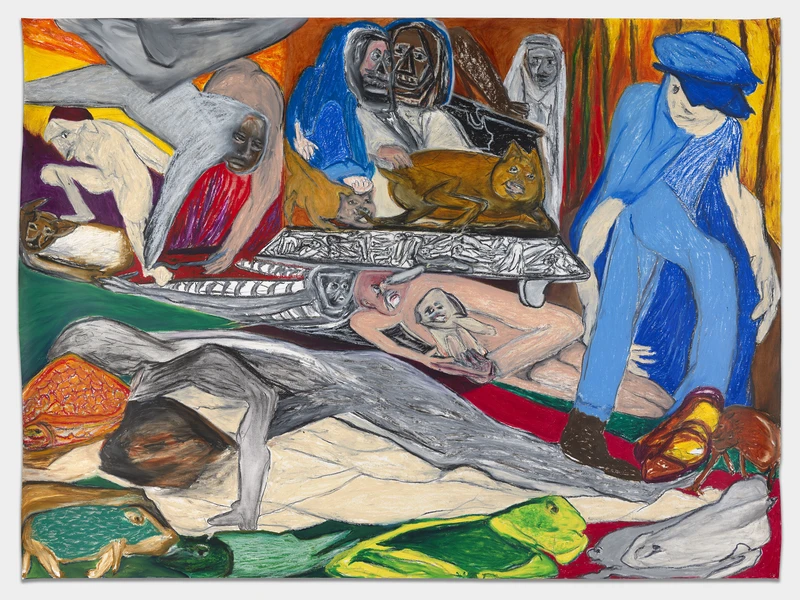Jacqueline de Jong: La petit mort
31 May-16 Aug 2024
PV 30 May 2024, 6-8pm


Pippy Houldsworth Gallery is pleased to present La petite mort, Jacqueline de Jong’s third solo exhibition with the gallery, bringing together new paintings made over the last two years with a group of rarely seen works executed sixty years ago. In her recent oeuvre de Jong comes full circle, exploring afresh the artistic lexicon of the earliest years of her career, when she first honed the vivid palette and expressive approach to mark-making for which she has become well known. In the intervening decades de Jong experimented with a range of styles, from pop to realism, in her analysis of the socio-political events that have shaped her lifetime. It is however the unique visual language developed in the mid-1960s that has punctuated her career, and which she reinvigorates in her work today, marrying a macabre figuration with themes of eroticism, death and violence, illuminating her own dark sense of humour.
De Jong began her career in Paris in 1961, where in the early part of the decade she was part of Situationist International, with whom she was active from 1960 to 1962, and befriended artists from Gruppe SPUR. Inspired by her avant-garde associations, de Jong was emboldened to disregard the prevalent post-war European artistic tradition in favour of a distinct and idiosyncratic style that encapsulated her revolutionary attitude to composition and characterisation. Examples from de Jong’s Accidental and Suicidal Paintings, both series begun in 1964, capture her dynamic and corporeal approach to both the personal and political. In Autostop Suicide (1965), a raucous expression of the sexual revolution that was taking over 1960s Paris, a humanoid figure dances into traffic, spatters of paint provoking a visceral reaction in the viewer. Such moribund imagery is typical of de Jong’s work from this period, in which skeletal figures cavort ecstatically with one another. Skeletons also appear with frequency in her work of the 2020s, including in In the Streets of L. (2022) where de Jong depicts one such figure sucking souls from a teeming pool that calls to mind the River Styx of Greek mythology.
De Jong has unfailingly interrogated human brutality in her work. She is critically aware of the cruelty of our day to day lives, in which the news cycle plays on a constant loop. While the works of the 1960s were concerned with the savagery of the everyday, since the 1980s de Jong has looked closely at war. In her new paintings she explores the ongoing conflicts in Ukraine and Gaza, paying close attention to the refugee emergency that both crises have engendered. In Bucha, Ukraine II (2022) a mass of entangled figures huddle within the canvas, escaping the flames that lick its upper edge. An image of a lone wheel harks back to de Jong’s Accidental Paintings of the mid-1960s, which featured bouncing automobile parts in a nod to a road accident witnessed by the artist. The cadaverous inhabitants in de Jong’s historic paintings are a reminder of the ghosts of Europe’s war-stricken past, and it is versions of these enigmatic characters that she uses to address the war-torn subjects of her paintings today, inciting the viewer to reckon with their own humanity as they process world events. By recycling the visual language that was so striking at the start of her career, de Jong intimates that unless we can learn from past experience, we risk history repeating itself.
Jacqueline de Jong (b. 1939, Hengelo, The Netherlands) lives and works in Amsterdam, The Netherlands and in Bourbonnais, France.
Opening in November 2024, the NSU Art Museum Fort Lauderdale, FL, will present the first US retrospective of de Jong’s work. Other recent solo museum exhibitions include The Ultimate Kiss, WIELS, Brussels (2021), touring to MOSTYN, Wales (2021-22) and Kunstmuseum Ravensburg, Germany (2022); Pinball Wizard: The Work and Life of Jacqueline de Jong, Stedelijk Museum, Amsterdam (2019); Jacqueline de Jong, Les Abattoirs, Toulouse (2018-19); Jacqueline de Jong & The Situationist Times, Malmö Konsthall (2018-19); and Jacqueline de Jong: Undercover in de kunst, Cobra Museum for Contemporary Art, Amstelveen (2003). Current and recent group exhibitions include Centre Pompidou, Paris (2024); Rijksmusem, Amsterdam (2024); Stedelijk Museum, Amsterdam (2022-23); Cobra Museum for Contemporary Art, Amstelveen (2023); BPS22 Musée d’art de la Province de Hainaut, Charleroi (2023); Musée d’Art Moderne de Paris (2022 and 2017); The Warehouse, Dallas (2021); Lenbachhaus, Munich (2020); Frans Hals Museum, Haarlem (2018); and Musée des Arts Décoratifs, Paris (2018).
In May 2023, de Jong was named Chevalier de l’Ordre des Arts et des Lettres by the French Ministry of Culture. In 2019 the AWARE Prize for Women Artists presented her with the Outstanding Merit Award in recognition of her exceptional career. That same year, These are Situationist Times! (Torpedo Press, Oslo), an in-depth history of the publication, was launched at Stedelijk Museum, Amsterdam, and MoMA PS1, New York, NY. Her archive, Jacqueline de Jong Papers, was acquired in 2011 by the Beinecke Library of Rare Books and Manuscripts, Yale University, New Haven, CT.
Centre Pompidou, Paris, acquired a major 1960’s work earlier this year. Other collections include Stedelijk Museum, Amsterdam; Moderna Museet, Stockholm; Le Centre national des arts plastiques (Cnap), Paris; Musée les Abattoirs, Toulouse; Amsterdam Museum; Cobra Museum for Modern Art, Amstelveen; Frans Hals Museum, Haarlem; Museum Arnhem; Museum Boijmans van Beuningen, Rotterdam; Museum Jorn, Silkeborg; Henie Onstad Kunstsenter, Oslo; MONA, Tasmania; Elie Khouri Art Foundation, Dubai; Kunstmuseum Göteborg; Lenbachhaus, Munich; Rachofsky Collection, Dallas, TX; and Musée d’Art Moderne de Paris.
Jacqueline de Jong, La petit mort press release
Download